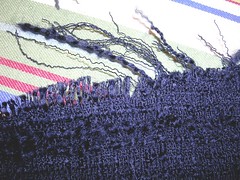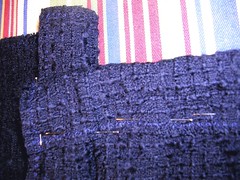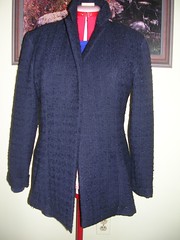
You can see from this close-up of frayed fabric that the threads in the weave are not uniform. There are bulky, wooly threads every so often that give the fabric its three dimensionality. But they are not loops.

Back to the skirt which is now finished. I decided to cut off an inch from the bottom and hem it up an inch and a half, to make it hit mid-kneecap. I also decided not to use seam binding on the raw edge. I think I thought it would be more subtle and less noticeable without seam binding, although since no one sees the inside of the hem anyway, I am sure I don't know why I considered this. I zigzag stitched all around the new cut edge on the hem and then turned it up and sewed the hem by hand.

After I attached the lining to the jacket all around the edges of the lapels and collar, I wanted to make sure the edge was as sharp as possible when I turned it right-side-out. I ironed open the seam first, after I trimmed it. Ironing the seam open pushes the seam itself right to the outside of the fold. Normally, if you just turn a garment right-side-out and try to press the edge of the lapels after it is turned, you will get some of the fabric dipping down into the seam. Then, you have to try to pick that fabric out of the trough formed by the seam. Press first and you won't have to do that.

When I hemmed the jacket, I first zigzagged the raw edge of the hem and then turned it up. Because the fabric is so loosely woven, it is simple to ease in the excess fabric in the hem, as I pin it to the jacket. After hand sewing and pressing, I don't have any tucks or bumps in the hem.

I still have to sew the puncture-proof lining to the jacket hem and hem the sleeves in the same way. Buttonholes and it's done!
4 comments:
If you ever get a chance to handle wool or rayon double knit give it a try. It is *nothing* like the poly double knits of our past. It is instead the most rich, luxurious, soft, drapey knit fabric... so lovely! (and a little pricey)
And no, I wouldn't call that a boucle either. I wonder what it was you saw that was labeled boucle back then...? Most of the ones I'm familiar with now are very nice, rather pricey, silk and wool ones. A lot of Chanel suits and jackets are made with boucle.
I also commonly see mohair boucle yarns for knitting.
I always think of boucle as expensive Chanel like! But I agree with the double knit. Reminds me of those poly slack suits old ladies wore in the 70's!
Your jacket is lookin good and you are almost there!
Heh I'm there with you on the double knit. The jacket looks beautiful!
Thanks for the comments! I have felt and drooled over silk jersey which is a knit. If I ever win the lottery and keep sewing, I will line everything in real silk. :)
As for the definitions, it is my brain's quirky way of doing things, to give slightly "off" definitions to things. I once did some psychological tests and one of them was to define words given to be verbally by the psychologist. I remember her eyebrows going up several times as I rambled through what I though were the meanings.
Post a Comment